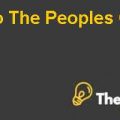
Problem Identification
Whirlpool Corporation is a famous and a global company with significant market share which makes Whirlpool the market leader in the industry of home appliances.In order to sustain the global image and competitiveness over its competitors the management of the Whirlpool considering to implement ERP.
It is expected that implementation of ERP would help to organize the system in such a way that the information could flow in all the worldwide offices of the whirlpool. It will improve the operations of the whirlpool and will enhance the effectiveness about all its operations and services.
But implementing ERP involves a very high initial installation cost. In addition to this high installation cost significant capital expenditure and personnel cost is also involved in order to operate ERP effectively.Whirlpool management is analyzing the financial viability of implementing the ERP in order to reorganize the information flow in the system.
Analysis
Whirlpool is a famous and world known company in the industry of home appliances with a significant market share. About every multinational firm is adopting modern techniques in order to run all the organizational operations effectively and timely.Whirlpool is in the manufacturing business of home appliance and its manufacturing units have spread in different countries all around the world.
Therefore, there is a need of better information flow within the organization in Europe as well as outside the European. ERP is a modern industry’s software with an ability to run the operations of the organizations effectively.
Whirlpool is a market leader in the industry of home appliances. Therefore, in order to maintain sustainable competitive advantage there is a need to run the organizational operations in a more efficient way than its competitors. By keeping in mind the global presence of the Whirlpool ERP is the much needed option for the company.
Whirlpool has a significant number of buyers with both industry buyers and end user buyers.Within the current system, Whirlpool is satisfying the demand of only 75 to 80% remaining customers are expected to switch to other companies. In order to meet the demand of customers Whirlpool manages its inventory to about 45 to 55 days of its sale because of the spread of manufacturing units around the world.
It is expected that by implementing ERP the product availability will increase to about 92% and with the efficient and timely flow of information its inventory will reduce to about 12 days of the sale, which will ultimately reduce the demand of working capital required to run the daily operations of the company.
Implementing ERP involves very high and substantial cost. It requires about 24 million dollars to purchase and run the equipment during first four years of the installation. In addition to this it would need about 900 million dollars for the purchase of licenses for the software.
Implementing ERP involves very high installation cost also in addition to the purchase of equipment and license cost. Implementation of ERP demands the training of employees in order to operate the software. According to rough estimates Whirlpool needs about 50 employees, along with the consultants hired from outside to train the employees.
It involves a significant pay to employees hired to run the ERP and a very large amount of fee for the consultants to operate the ERP and educate its employee’s to operate ERP. In addition to staff salary and consultant fee 600 million dollars per year also needed for the first five years in order to company with the required demand of the ERP and it is expected that its cost will increase with the 600 million dollars in subsequent years after its installation. It is also expected that annually 100,000 dollars also needed from year 2000 for the purpose of maintenance and in subsequent its amount will increase by 100,000 each year till 2004 and will remain 400,000 till the sale of the license.
In addition to these high purchase and installation cost there are significant cost savings also expected from the implementation of the ERP. It will reduce the number of desk employees because mostly task will perform on the software and will reduce the need fora workforce which needed before implementing ERP.
Therefore, their reduction in the need of workforce will reduce the outflows in the form of salary of these employees. Beside this there are a number of cost savings will occur with the help of implementing ERP. It will reduce the number of purchase returns from customer by improving the processes; it will reduce the demand of warehouse space and the list of many more costs which could be saved by implementing ERP..........................
This is just a sample partial case solution. Please place the order on the website to order your own originally done case solution.












